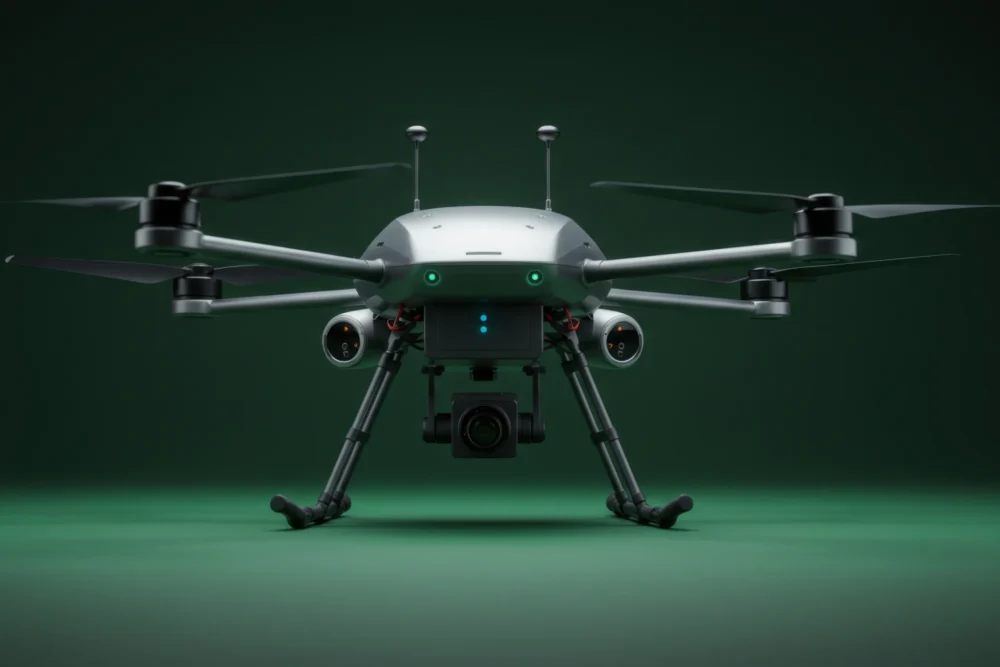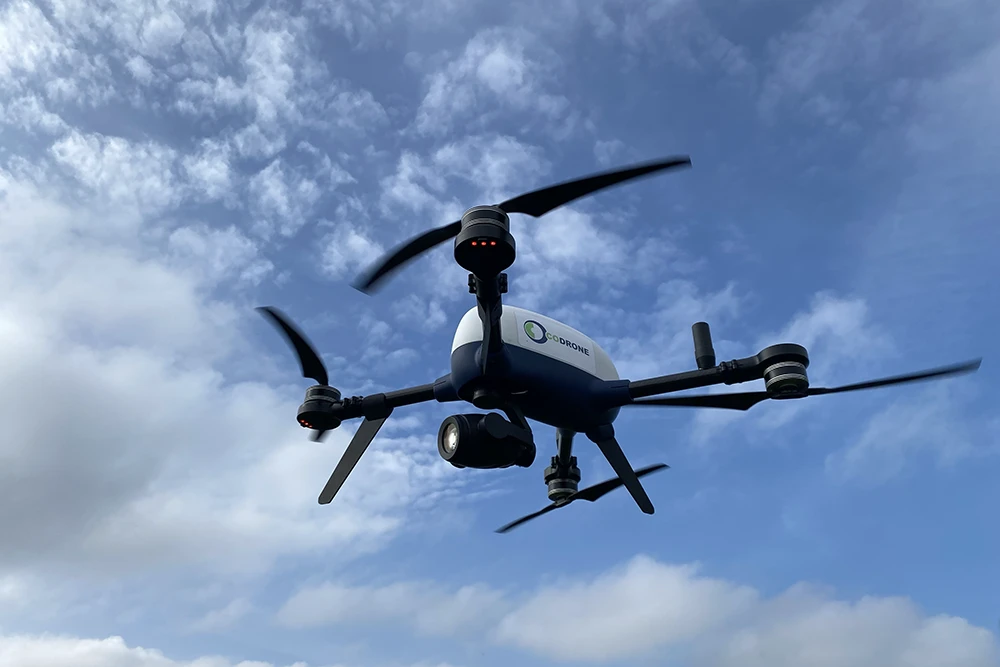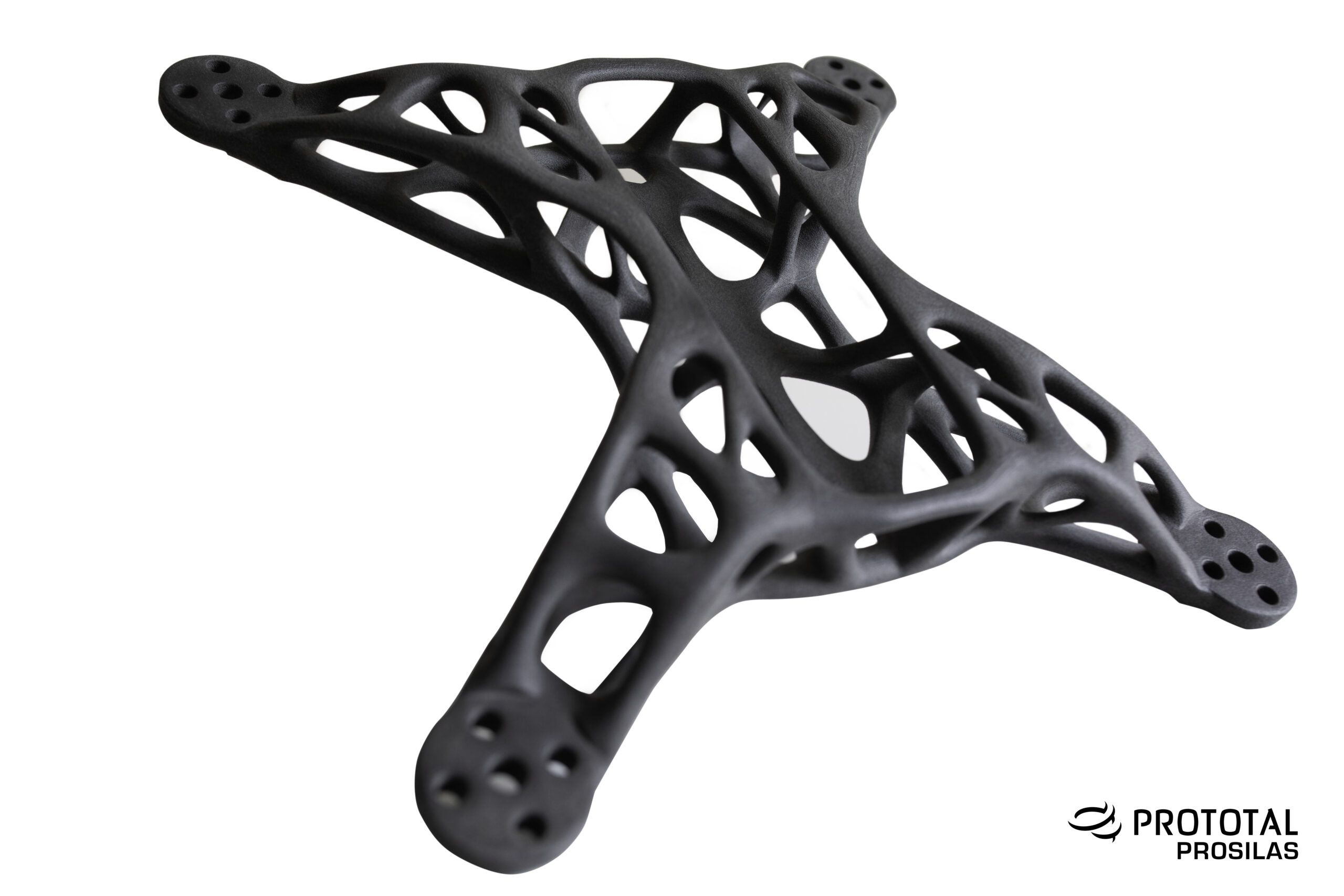Stronger, Lighter, Faster – Drones & 3D Printing
Industrial 3D Printing for the Drone Sector
Next-generation drones, or UAVs (Unmanned Aerial Vehicles), are profoundly transforming key sectors such as surveillance, industrial inspections, precision agriculture, and logistics. Simultaneously, 3D printing has established itself as a pivotal technology for innovating industrial production. It enables the creation of numerous complex components in short timeframes, reducing waste and costs compared to traditional methods.

In the UAV context, additive manufacturing represents a paradigm shift for producers. The ability to create complex geometries without mold constraints and with minimal waste makes this technology ideal for a sector that demands agility, precision, and continuous innovation.
Why is Additive Manufacturing Perfect for Drone Production?
Implementing 3D printing in the serial production of drones offers numerous advantages, impacting engineering, economic, and production aspects:
- Weight Reduction and Performance Enhancement: Through topological optimization, material can be removed where unnecessary, significantly reducing weight without compromising strength. Less weight translates to greater autonomy, efficiency, and maneuverability, especially when drones must cover long distances or carry sensors.
- Complex Designs and Design Freedom: Additive manufacturing allows for the production of single-component parts, even with organic, lattice, or hollow shapes, difficult to achieve otherwise. This eliminates joints and assemblies, simplifying production and enhancing functionality.
- Extreme Customization: Each function requires a different drone, and with 3D printing, supports, landing gear, sensor housings can be quickly customized to specific needs, even in unique batches.
- Accelerated R&D: From CAD file to component in a few days. Designers can test, modify, and relaunch versions in record time, drastically reducing time-to-market.
- Flexible Production Even in Small Volumes: For many drone manufacturers, volumes don’t justify molds or equipment. Additive manufacturing makes small-scale or on-demand production accessible.
- Efficiency and Sustainability: 3D printing uses only the necessary material. It reduces waste, simplifies logistics, and promotes a leaner, more responsible supply chain. It’s possible to choose CarbonReduced materials, like PA2200, or bio-based materials, like PA11, for improved sustainability performance.
Why SLS?
Among additive technologies, Selective Laser Sintering (SLS) stands out for quality, precision, and reliability in industrial production and for its extensive material portfolio.
- Complex Geometries Without Supports: Unfused powder supports the part during printing, allowing for intricate shapes, undercuts, internal channels, and lightweight lattices. Unibody structures with integrated functionalities—cable guides, threaded seats, attachments—can be created in a single step.
- Extra-Large Printing Volumes: Prototal possesses the technological capacity to produce up to 2,000 units per day thanks to large-format SLS systems (up to 700×380×580 mm). Small-sized units are processed in batches to optimize productivity and ensure uniform quality. Large-sized units can be printed as a single monolithic block.
- High-Performance Materials: Drones often operate in harsh environments. SLS supports lightweight and durable technical materials, ideal for resisting heat, impacts, vibrations, and humidity.
Prototal Group’s Material Portfolio for Drones
The Prototal Group offers a wide range of materials, but for the drone sector, the following stand out for their specific properties and superior performance:
- Hyper-light Carbon: A composite material based on polyamide 12 reinforced with carbon fiber and hollow glass spheres, designed for applications requiring an excellent strength-to-weight ratio. Its extremely low density (0.82 g/cm³) not only lightens components but also allows for the creation of floating parts, ideal for nautical applications or amphibious UAVs. With tensile strength (50 MPa) surpassing standard materials like PA2200 and a precise, uniform surface finish, Hyper-light Carbon is processed with high precision on EOS P770 printers, enabling the production of large monolithic components.
- PA2210 Flame Retardant: Based on PA2200 but enriched with a halogen-free flame-retardant additive, PA2210 FR is the ideal choice for critical environments like aerospace and motorsport. It complies with UL 94 V-0 standards for thicknesses above 2 mm, the FMVSS 302:1991 regulation for US automotive interiors, and holds the Blue Card certification for 3D printing. Its flame-retardant properties are crucial for reducing flame propagation risk, essential for applications where fire safety and chemical resistance are imperative.
- PA2200 CarbonReduced: PA2200 is the “workhorse” material of SLS 3D printing: a versatile, durable technical nylon certified for biocompatibility and food contact. The CarbonReduced version maintains all known mechanical characteristics of PA2200 but with a 45% lower environmental impact in terms of CO₂. Thanks to its balanced profile and aesthetic surface quality, PA2200 CarbonReduced is perfect for combining sustainability, precision, and functionality.

CODRONE – Autonomous Aerial Inspection
The Danish startup CODRONE develops autonomous drones for pilotless inspection and surveillance. In developing their first product, Aluco, traditional methods proved inadequate to meet requirements for robustness, lightness, and advanced geometry.
Thanks to SLS printing, Prototal Dk assisted CODRONE in creating functional prototypes and transitioning directly to final production, achieving:
- Lightweight and robust shells for electronics and sensors;
- Reduction in the number of parts and simplification of assembly;
- Shorter development times and costs.
“With industrial 3D printing, we can move directly from prototype to final production. The quality and finish of the components provided by Prototal are extremely high.”
— Kristian Husum Laursen, CEO of CODRONE

Lightweight Drone Frame
The project began with a structural optimization phase, where software analyzed the loads, constraints, and operating conditions the frame would face in flight. The result was an organic geometry, reduced to the essentials, using only the material necessary to ensure strength and stability.
For production, SLS technology and a composite material based on polyamide and carbon fiber (PA603CF) were chosen, selected for its advanced mechanical properties, lightness, and thermal resistance.
The result? A frame 50% lighter than its aluminum equivalent, with improved mechanical performance and greater vibration absorption capacity.
Thanks to its vertical integration, the Prototal Group supports clients throughout the entire process: from the first prototype to serial production. If volumes increase, production can be transferred to injection molding without changing suppliers.
Additive manufacturing becomes an integral part of the production strategy.
Discover How We Can Support Your Next UAV Project
Do you have an innovative idea for a drone? Are you seeking the right partner to develop lightweight, durable components ready for production? Contact us for a dedicated consultation. Together, we can transform your concept into reality, with the speed, precision, and reliability of industrial 3D printing.
Prototal Group Prototal Group is the largest provider of 3D printing, tooling, and injection molding services in Northern Europe. With a highly specialized team and advanced technologies, the group supports companies across various sectors, from automotive to medical, offering rapid prototyping and serial production solutions. Prototal Prosilas represents the group’s Italian division, with strong expertise in Selective Laser Sintering (SLS) and the most advanced additive manufacturing technologies.
